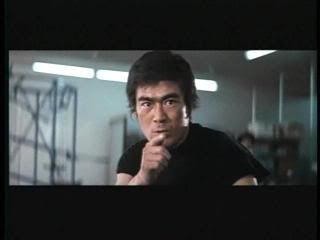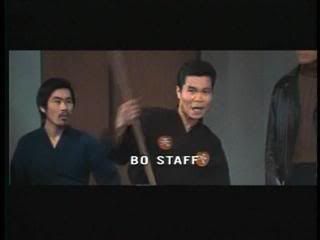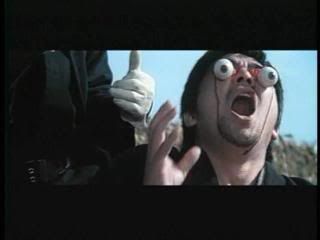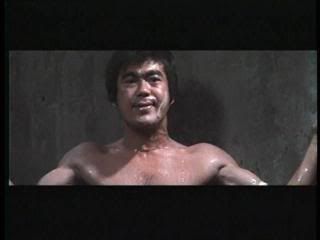A padded retread of the first film in many ways, Return of The Streetfighter still features all of the elements which made the first film such a bloody blast to watch. There's still the funky score and outrageous visuals, we still get copious amounts of ultraviolence, and Sonny Chiba brings bucket-loads of charisma to the party. It's a shame then that the already scant 80 minute run time is stretched by some lengthy superfluous flashbacks to the first film. Fans will find plenty to love here, but if you didn't care for the original film there's little here that will change your mind.
Filmed almost immediately after the first film, director Shigehiro Ozawa starts this one off with a bang: Hired to kill a man in police custody, Takuma Tsurugi (Chiba) decides to get himself intentionally arrested by driving his motorcycle at ridiculous speeds and beating up on a bunch of cops. Once in the police station, Tsurugi finds his target and proceeds to pierce his vocal cords with his fingers before taking on the entire station and escaping out the window, all while wearing handcuffs! He escapes with the help of his new plucky, beat-talking sidekick: Pin Boke ("Kitty" in the english dub). This sequence is one of the best of the series, so it's a minor disappointment when the plot starts cover a lot of the same territory as the first film. Takuma has been hired by Isamu Otaguro, who runs a local karate dojo but is suspected (rightfully) of working with the mafia. After refusing to kill Kendo Masaoka (who Tsurugi tangled with in the first film) who has threatened to turn Otaguro in, Tsurugi soon becomes a target of Otaguro and his hired goons.
It's at this point where the film becomes a series of impressive set pieces with Tsurugi being attacked while skiing (which leads to a completely ridiculous eye-popping scene), at a massage parlor, and by his old nemesis Junjo (featuring an electronic voice box to replace the one torn out by Tsurugi in the first film). The confrontation with Junjo ends badly, and a despondent Pin Boke has to nurse him back to health before he goes off and kicks the ass of everyone left alive. No promises this time, but another sequel (again made in 1974!) was soon on its way.
We're all here to see Chiba (Viva Chiba!), and his character here is slightly softened and sympathetic compared to his sell-women-into-slavery ways in the first film. He's still an unrepentant prick with a chip on his shoulder, but he's a little more fun and even gets to crack a smile during a ridiculous conversation with a self proclaimed karate expert (who manages to severely burn himself on some sauna rocks). Chiba is still in top form with his karate skills, and may even show off a bit more acrobatics than the first film, and the film is as vicious and violent as ever - though only the eye-popping reaches the dizzying heights of the x-ray head smash from the first film.
Shigehiro Ozawa keeps the action under control while capturing every grimace and snarl from Chiba, and there's a nice touch where titles are presented to identify Japanese weapons being used in the early scenes. While these scenes feel a bit more like padding (and i'm unsure if they are included in the original Japanese version), seeing these weapons in action are always a lot of fun (and gave me Teenage Mutant Ninja Turtles flashbacks) - though not all actually come into play in the film.
Once again the secondary characters are a bit weak, and Kitty's jive talking must have seemed dated even when the film was related, but they get beaten senseless quite effectively. Bringing back Junjo was a nice touch, and the addition of the robotic voice-box adds a proper comic-book touch, though he doesn't get to show off his abilities like he did in the first film.
Image quality is a little rougher than for the first Streetfighter, but it's still a quite clean, apparently uncut print that is easily available because of its public domain status. The dubbing is a little rougher as well, and the habit of anglicizing names continues with Takuma once again referred to as "Terry". Sound is perfectly fine, with Toshiaki Tsushima's awesome funky soundtrack coming through loud and clear. I worried that we would be denied the awesome Streetfighter theme music, but it's saved for Tsurugi's climactic recovery and it is appropriately awesome.
While a step down from the revelation that is The Streetfighter, Return is still required viewing for fans of martial arts films, of Sonny Chiba, or for fans of scenes where characters appear astounded that their eyeballs have been punched out of their skulls. Almost all of the elements that made the original great return here, and you can watch the whole thing right here. After this film the series produced diminishing returns, but there's no excuse to not check this one out.















4 comments:
I love this movie a lot, but I was surprised to discover that I love all of the Sister Street Fighter movies above the subsequent Street Fighter sequels.
Probably because I had a HUGE crush on Sue Shiomi when I was a kid.
I've got to get my DVD collection organized, because I think I've got the Sister Street Fighter collection that I bought for 8 bucks or so. Oh, the joys of DVD purchases--and the perils of keeping them in order!
Now that's interesting to hear. I've actually never checked out the Sister Street Fighter films, though i've always understood that they were pale imitations of the Chiba originals. Is Sue Shiomi similarly intense and dickish, or is the "feel" a bit different?
The Sister Street Fighter is probably the polar opposite in tone from the Street Fighter movies.
Shiomi usually ends up as the virginal warrior maiden in most Toho action productions. There isn't much psychology in them since she's about as squeaky clean and honorable as youc an get but watching her fight is amazing.
You can tell that the action scenes are dumbed down because if she fought as hard as she could, you probably couldn't capture her movement on film.
Post a Comment